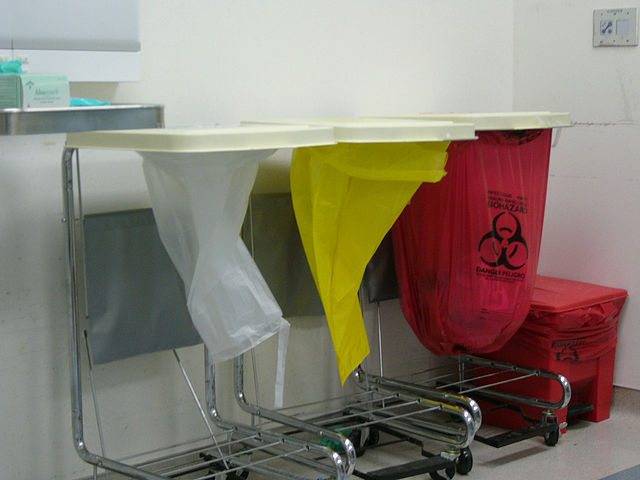(image credit Stephen Witherden – Medical Waste. Sous licence CC BY 2.0 via Wikimedia Commons)
It’s no secret that the disposal of medical waste can be expensive. Costs continue to grow based on our aging population and an increase in health care services. For this reason, numerous institutions are in search of ways to save that do not compromise environmental laws.
Luckily, there is a simple solution and it doesn’t require a financial investment. By properly classifying your facility’s medical waste, you can significantly conserve on expenditures.
While this method sounds straightforward in practice, however, it can still be difficult to break bad habits. But once you train your staff to segregate medical waste correctly, you will see your disposal costs start to decrease.
Overuse of Red Bags
A busy doctor’s office can mean it’s often easier to take shortcuts when it comes to getting rid of waste. Some facilities have more red bags readily available than regular trashcans. This reality can encourage members of your staff to put generic waste in red bags instead of separating them into appropriate categories.
In addition, certain individuals may deliberately place all garbage in red bags just to be safe. Again, this tendency is wasteful, even though it may provide peace of mind. But the liberal use of red bags is a common mistake and can be corrected with some clarifications.
The bottom line is that you need to educate your employees about what belongs in red bags and what should be put in generic trash bins. Once you get your staff into the habit of segregating the medical waste your office generates, you will see substantial savings.
Items Classified as Medical Waste
A logical way to train your staff on true medical waste is to provide a list of items that should be put in red bags. Basically, medical waste is defined as anything that contains large amounts of blood or Other Potentially Infectious Materials (OPIM). These items include:
- Semen and vaginal fluids
- Saliva due to dental work
- Cerebrospinal fluid, synovial fluid, pericardial fluid and pleural fluid, peritoneal and amniotic fluid
- Bodily fluids that include blood
- Unfixed human or animal tissue or organs
In addition, materials that have certain common characteristics are viewed as medical waste. These items include:
- Materials with liquid or semi-liquid blood and OPIM
- Materials that can release liquid or semi-liquid blood and OPIM
- Items that contain dried or caked blood or OPIM
- Sharps that are contaminated with blood or OPIM
- Pathological or microbiological wastes
Based on these guidelines, it should be noted that urine and feces are not considered medical waste. Therefore, garbage that contains either one of these materials should not be put in red bags. The same guidance can be applied to soiled (but not bloodied) gloves, table and tray covers and empty medical vials.
Even items that have minute traces of blood or OPIM should not be thrown into red bags. This is because small amounts are not enough to cause contamination when compressed or released. So you can put these items in regular trash bins without further treatment and save room for relevant waste in your red bags.
A good rule of thumb is that if an item is saturated or dripping with blood or OPIM, then it qualifies for red bag disposal.
However, even items that only have tiny amounts of blood or OPIM, they still need to be handled using Universal Precautions.
Review and Revise Procedures
In order to ensure your employees begin separating waste according to proper classifications, it’s essential that you review and revise your office’s procedures. You should also take steps to provide large-mouthed trash bins around your facility as needed. This will lessen the over-reliance on red bags for waste that can be placed with regular garbage.
You may find certain employees are resistant to these changes simply due to ingrained habits. However, by providing detailed training and follow-up, you will be able to help staff members make the transition to proper separation of waste.
In Conclusion
While it may seem difficult to change and enforce your new policies, your office will soon see many financial benefits. Saving red bags for true medical waste will enable you to allocate more money for other important things your office needs. From better equipment to serve your patients to increased salaries for your staff, proper medical waste classification can enhance your facility in many positive ways.




